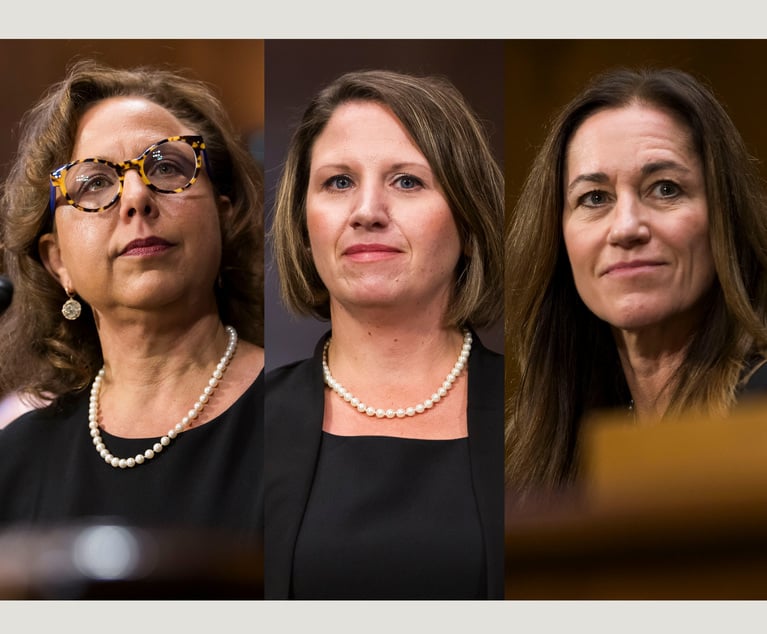Getting Out of Dodge II: Any Defendant Does Not Mean 'Any' Defendant
Does a “defendant” under the removal statute mean a third-party counterclaim defendant? Does “any defendant” under the Class Action Fairness Act (CAFA) truly mean "any" defendant? According to the U.S. Supreme Court, the answer, in all of these questions, is no.
August 22, 2019 at 12:07 PM
7 minute read
 Shannon McClure, left, and Alyssa Conn, right, of Reed Smith.
Shannon McClure, left, and Alyssa Conn, right, of Reed Smith.
You’ve just received a call that a defendant has filed third-party class action counterclaims against your client in state court. Your client wants to remove the claims against it to federal court, in order to benefit from the direct attention and case management that a federal court provides. You know that an original plaintiff may not remove a counterclaim against it, but what about a third-party counterclaim defendant? Does a “defendant” under the removal statute mean a third-party counterclaim defendant? Does “any defendant” under the Class Action Fairness Act (CAFA) truly mean any defendant? According to the U.S. Supreme Court, the answer, in all of these questions, is no.
In a recent article, ”Getting Out of Dodge: Removing a Case From State to Federal Court,” we provided an overview of the procedure regarding removal as well as some of the grounds for removing a civil case from state to federal court. Since then, the Supreme Court, in Home Depot v. Jackson, ruled in a 5-4 decision to winnow the list of defendants eligible to remove a case from state court to federal court. This article is a follow-up and provides an overview of the Supreme Court’s recent decision and an update to the state of the law surrounding who can file for removal.
Overview of ‘Home Depot v. Jackson’
In Home Depot, plaintiff CitiBank, filed a debt-collection action against defendant George Jackson in North Carolina in state court, alleging that Jackson was liable for charges incurred on a Home Depot credit card. Jackson subsequently answered the complaint and filed an individual counterclaim against CitiBank; critically, Jackson also filed third-party class action claims against Home Depot USA and Carolina Water Systems.
Jackson claimed that Home Depot and Carolina Water Systems had engaged in a scheme to induce homeowners to buy water treatment systems at inflated prices in violation of North Carolina referral sales and consumer protection laws. While CitiBank subsequently dismissed its claims against Jackson, Home Depot and Carolina Water Systems remained third-party counterclaim defendants in the action. Accordingly, Home Depot filed a notice of removal, citing the general removal statute, 28 U.S.C. Section 1441(a), and the Class Action Fairness Act’s removal provision, 28 U.S.C. Section 1453(b). Jackson moved to remand, arguing that “precedent barred removal by a ‘third-party/additional counter defendant like Home Depot.’” The district court granted Jackson’s motion and the U.S. Court of Appeals for the Fourth Circuit affirmed.
Home Depot appealed to the Supreme Court, which granted Home Depot’s petition for a writ of certiorari. The Supreme Court considered two issues: whether the holding in Shamrock Oil & Gas v. Sheets—that an original plaintiff may not remove a counterclaim against it—should extend to third-party counterclaim defendants; and whether a third party named in a class-action counterclaim brought by the original defendant can remove if the claim otherwise satisfies the jurisdictional requirements of CAFA.
Who Is a Third-Party Counterclaim Defendant?
Before diving into the court’s decision, it is important to understand who a third-party counterclaim defendant is. In its opinion, the Supreme Court used the term “third-party counterclaim defendant” to refer to an additional defendant to a counterclaim asserted against the original plaintiff. Thus, a third-party counterclaim defendant is not an original party to the action filed by the original plaintiff and, unlike the original plaintiff, has no role in selecting the forum of the suit.
Why Isn’t a Third-Party Counterclaim Defendant Really a Defendant?
The general removal statute, 28 U.S.C. Section 1441(a) provides that “any civil action brought in a state court of which the district courts of the United States have original jurisdiction, may be removed by the defendant or the defendants, to the district court of the United States for the district and division embracing the place where such action is pending.” The court had already previously held, in Shamrock Oil, that an original plaintiff who became a counterclaim defendant was not a “defendant” within the meaning of Section 1441(a) and, therefore, could not remove a counterclaim against it. Thus, the first issue the court considered was whether a third-party counterclaim defendant was more like the plaintiff attempting to remove a counterclaim against it or more like an original defendant.
Ultimately, the majority opinion, authored by Justice Clarence Thomas and joined by Justices Ruth Bader Ginsburg, Stephen Breyer, Sonia Sotomayor and Elena Kagan, reasoned that the court could not construe the statutory language in a vacuum: the statute does not broadly refer to defendants of “claims,” but specifically to defendants in a “civil action … of which the district courts of the United States have original jurisdiction.” As a counterclaim is irrelevant to whether a district court has original jurisdiction, a third-party counterclaim defendant was not encompassed by the statute. Thus, the majority held that the role of a third-party counterclaim defendant is more like that of the counterclaim defendant considered in Shamrock Oil, and thus is not a “defendant” who could remove under Section 1441(a).
CAFA’s ‘Any’ Defendant Language
The court also separately considered whether CAFA permitted removal by a third-party counterclaim defendant. CAFA allows for removal by “any defendant” to a “class action.” Home Depot argued that the statute’s reference to a “class action” rather than a “civil action” demonstrated that CAFA’s provision was broader than Section 1441 and it permitted any party sued in a large state court class action to remove the case to federal court.
The majority disagreed. It held that the context of the relevant provisions within CAFA demonstrates that Congress only intended to alter certain restrictions on removal, and not to expand the class of parties who can remove a class action under Section 1441. Moreover, the majority held would be inconsistent to interpret “defendant” to have different meanings in the different removal provisions, because both CAFA and Section 1441 rely on procedures for removal in 28 U.S.C. Section 1446.
The Dissent
The dissent, authored by Justice Samuel Alito and joined by Chief Justice John Roberts, Justice Neil Gorsuch and Justice Brett Kavanaugh, vehemently disagreed with the majority. The dissenting justices argued that the majority’s interpretation created a loophole that could be exploited by defendants into an “unremovable attack on the defendant’s ‘lending and credit policies’ on behalf of a whole class of plaintiffs.” The majority acknowledged the result, but contended that, because Congress had written the statute that way, it was for Congress to amend the statute if it shared the dissent’s view.
Conclusion
In sum, while such cases might not occur with great frequency, businesses should be aware of the risk of being pulled into state court class actions as a third-party counterclaim defendant, with no removal rights.
Shannon McClure is a partner in the Reed Smith’s global commercial disputes group, focusing her practice on complex civil litigation on behalf of national and multinational companies. She can be reached at [email protected].
Alyssa Conn is an associate in the firm’s global commercial disputes group. She focuses her practice on complex commercial litigation and insurance coverage disputes in federal and state courts. Contact her at [email protected].
This content has been archived. It is available through our partners, LexisNexis® and Bloomberg Law.
To view this content, please continue to their sites.
Not a Lexis Subscriber?
Subscribe Now
Not a Bloomberg Law Subscriber?
Subscribe Now
NOT FOR REPRINT
© 2025 ALM Global, LLC, All Rights Reserved. Request academic re-use from www.copyright.com. All other uses, submit a request to [email protected]. For more information visit Asset & Logo Licensing.
You Might Like
View All
Pa. Federal District Courts Reach Full Complement Following Latest Confirmation

The Defense Bar Is Feeling the Strain: Busy Med Mal Trial Schedules Might Be Phila.'s 'New Normal'
7 minute read
Federal Judge Allows Elderly Woman's Consumer Protection Suit to Proceed Against Citizens Bank
5 minute read
Judge Leaves Statute of Limitations Question in Injury Crash Suit for a Jury
4 minute readTrending Stories
- 1M&A Transactions and AB 1824: Navigating New Privacy Compliance Challenges
- 2Devin Nunes, Former California GOP Congressman, Loses Move to Revive Defamation Suit
- 3Judge Sides With Retail Display Company in Patent Dispute Against Campbell Soup, Grocery Stores
- 4Is It Time for Large UK Law Firms to Begin Taking Private Equity Investment?
- 5Federal Judge Pauses Trump Funding Freeze as Democratic AGs Launch Defensive Measure
Who Got The Work
J. Brugh Lower of Gibbons has entered an appearance for industrial equipment supplier Devco Corporation in a pending trademark infringement lawsuit. The suit, accusing the defendant of selling knock-off Graco products, was filed Dec. 18 in New Jersey District Court by Rivkin Radler on behalf of Graco Inc. and Graco Minnesota. The case, assigned to U.S. District Judge Zahid N. Quraishi, is 3:24-cv-11294, Graco Inc. et al v. Devco Corporation.
Who Got The Work
Rebecca Maller-Stein and Kent A. Yalowitz of Arnold & Porter Kaye Scholer have entered their appearances for Hanaco Venture Capital and its executives, Lior Prosor and David Frankel, in a pending securities lawsuit. The action, filed on Dec. 24 in New York Southern District Court by Zell, Aron & Co. on behalf of Goldeneye Advisors, accuses the defendants of negligently and fraudulently managing the plaintiff's $1 million investment. The case, assigned to U.S. District Judge Vernon S. Broderick, is 1:24-cv-09918, Goldeneye Advisors, LLC v. Hanaco Venture Capital, Ltd. et al.
Who Got The Work
Attorneys from A&O Shearman has stepped in as defense counsel for Toronto-Dominion Bank and other defendants in a pending securities class action. The suit, filed Dec. 11 in New York Southern District Court by Bleichmar Fonti & Auld, accuses the defendants of concealing the bank's 'pervasive' deficiencies in regards to its compliance with the Bank Secrecy Act and the quality of its anti-money laundering controls. The case, assigned to U.S. District Judge Arun Subramanian, is 1:24-cv-09445, Gonzalez v. The Toronto-Dominion Bank et al.
Who Got The Work
Crown Castle International, a Pennsylvania company providing shared communications infrastructure, has turned to Luke D. Wolf of Gordon Rees Scully Mansukhani to fend off a pending breach-of-contract lawsuit. The court action, filed Nov. 25 in Michigan Eastern District Court by Hooper Hathaway PC on behalf of The Town Residences LLC, accuses Crown Castle of failing to transfer approximately $30,000 in utility payments from T-Mobile in breach of a roof-top lease and assignment agreement. The case, assigned to U.S. District Judge Susan K. Declercq, is 2:24-cv-13131, The Town Residences LLC v. T-Mobile US, Inc. et al.
Who Got The Work
Wilfred P. Coronato and Daniel M. Schwartz of McCarter & English have stepped in as defense counsel to Electrolux Home Products Inc. in a pending product liability lawsuit. The court action, filed Nov. 26 in New York Eastern District Court by Poulos Lopiccolo PC and Nagel Rice LLP on behalf of David Stern, alleges that the defendant's refrigerators’ drawers and shelving repeatedly break and fall apart within months after purchase. The case, assigned to U.S. District Judge Joan M. Azrack, is 2:24-cv-08204, Stern v. Electrolux Home Products, Inc.
Featured Firms
Law Offices of Gary Martin Hays & Associates, P.C.
(470) 294-1674
Law Offices of Mark E. Salomone
(857) 444-6468
Smith & Hassler
(713) 739-1250





